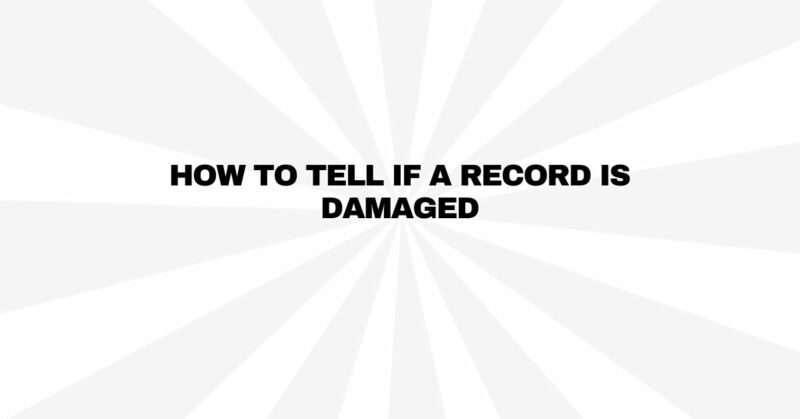Vinyl records have enjoyed a resurgence in popularity, attracting both audiophiles and music enthusiasts who appreciate their analog charm and rich sound quality. Whether you’re a seasoned collector or just starting your vinyl journey, knowing how to identify and assess vinyl record damage is essential for maintaining the quality of your collection. In this comprehensive guide, we will explore common types of vinyl record damage and provide you with practical tips on how to tell if a record is damaged.
Common Types of Vinyl Record Damage:
Vinyl records are delicate and can suffer from various types of damage over time or due to mishandling. Here are some of the most common types of vinyl record damage:
1. Surface Scratches:
Surface scratches are one of the most frequent forms of vinyl record damage. These are visible marks on the playing surface of the record and can range from light scuffs to deeper grooves. While minor surface scratches may not significantly affect sound quality, deep scratches can cause audible pops and crackles during playback.
2. Warping:
Warping occurs when a vinyl record loses its flat shape and takes on a slight curve. Warped records may skip or cause tracking issues when played on a turntable. This type of damage is often caused by exposure to heat or improper storage.
3. Cracks and Breaks:
Physical accidents or mishandling can lead to cracks or breaks in vinyl records. These fractures render the record unplayable and can result in complete separation of a portion of the record.
4. Ring Wear:
Ring wear is a type of damage to the album cover rather than the vinyl itself. It occurs when the inner sleeve rubs against the cover’s printed surface, creating circular patterns of wear. While this does not affect sound quality, it can diminish the aesthetic value of the album cover.
5. Groove Wear:
Groove wear is gradual wear and tear that occurs on the grooves of a vinyl record over time due to repeated playback. It can lead to a decrease in sound quality, with increased background noise and reduced fidelity.
6. Surface Scuffs:
Surface scuffs are shallow marks on the vinyl surface. While they are less severe than deep scratches, they can still contribute to minor pops and crackles during playback.
How to Tell if a Vinyl Record is Damaged:
Identifying vinyl record damage requires a careful inspection of both the record and its album cover. Here’s how to tell if a vinyl record is damaged:
1. Visual Inspection:
- Check for Surface Scratches: Hold the record under a bright light and inspect it for visible surface scratches. Rotate the record gently to examine all areas.
- Look for Warping: Place the record on a flat surface and observe if it lies flat. Any noticeable curvature or wobble indicates warping.
- Examine for Cracks and Breaks: Inspect the record for any visible cracks, chips, or breaks. Pay particular attention to the outer edge, where damage is more common.
- Check the Album Cover: Examine the album cover for ring wear, seam splits, and other signs of damage. A damaged cover may indicate potential issues with the vinyl inside.
2. Tactile Inspection:
- Run Your Fingertips: Gently run your fingertips across the surface of the record. You may feel surface scuffs and scratches, which can be indicators of damage.
3. Auditory Inspection:
- Listen for Pops and Crackles: When playing the record, listen for audible pops and crackles. These sounds often result from surface scratches or scuffs.
- Check for Skips: Pay attention to any repeated skips or jumps in the playback. This can be a sign of warping or groove wear.
4. Play the Entire Record:
To thoroughly assess the condition of a vinyl record, it’s essential to play the entire record. Some forms of damage, such as groove wear or warping, may only become evident during playback.
5. Use a Magnifying Glass:
For a more detailed examination, use a magnifying glass or a high-quality stylus inspection tool to inspect the grooves for subtle damage that may not be visible to the naked eye.
Conclusion:
Understanding how to tell if a vinyl record is damaged is crucial for collectors and enthusiasts who want to maintain the quality of their vinyl collection. Regular visual inspections, tactile assessments, and auditory examinations can help you identify surface scratches, warping, cracks, and other forms of damage. By taking care to handle your records properly and store them in optimal conditions, you can minimize the risk of damage and ensure that your vinyl records continue to provide you with the joy of analog music for years to come.

